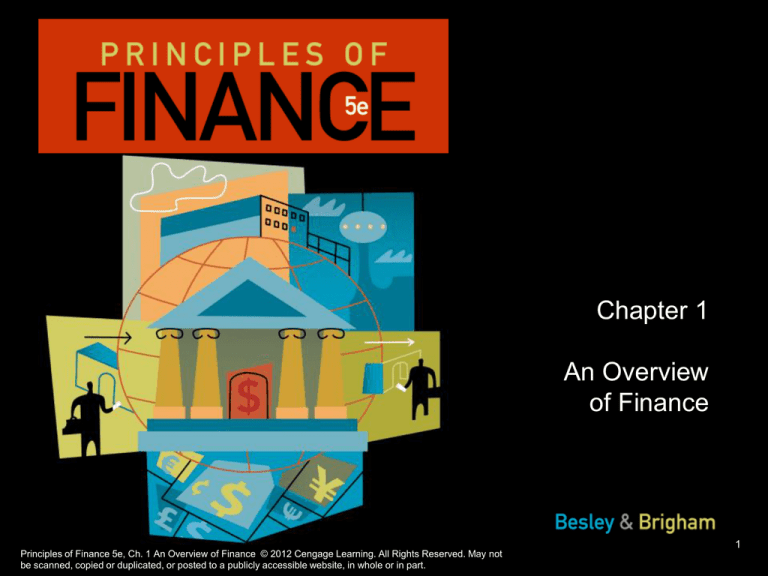
Chapter 1
An Overview
of Finance
1
Principles of Finance 5e, Ch. 1 An Overview of Finance © 2012 Cengage Learning. All Rights Reserved. May not
be scanned, copied or duplicated, or posted to a publicly accessible website, in whole or in part.
Chapter 1 – Learning Objectives
Explain what finance entails and why everyone should
have an understanding of basic financial concepts.
Describe how the finance discipline has changed
during the past century.
Explain in general how value is measured and what it
means to maximize value.
Explain what it means to be sustainable and how
making appropriate financial decisions promotes
sustainability.
Explain what the terms lean manufacturing and lean
finance mean.
Principles of Finance 5e, Ch. 1 An Overview of Finance © 2012 Cengage Learning. All Rights Reserved.
May not be scanned, copied or duplicated, or posted to a publicly accessible website, in whole or in part.
2
What is Finance
Finance is concerned with decisions
about money
To make sound financial decisions,
remember:
More value is preferred to less
The sooner cash is received the more
value it has
Less risky assets are more valuable than
risky assets
Principles of Finance 5e, Ch. 1 An Overview of Finance © 2012 Cengage Learning. All Rights Reserved.
May not be scanned, copied or duplicated, or posted to a publicly accessible website, in whole or in part.
3
Four Major Areas of Finance
Financial markets and institutions
Investments
Financial services
Managerial finance
Principles of Finance 5e, Ch. 1 An Overview of Finance © 2012 Cengage Learning. All Rights Reserved.
May not be scanned, copied or duplicated, or posted to a publicly accessible website, in whole or in part.
4
Financial Institutions
Banks
Insurance companies
Savings and loans
Credit unions
Principles of Finance 5e, Ch. 1 An Overview of Finance © 2012 Cengage Learning. All Rights Reserved.
May not be scanned, copied or duplicated, or posted to a publicly accessible website, in whole or in part.
5
Investments
Major Functions
Determining the values, risks and returns of
financial assets
Determining the optimal mix
of securities that should be
held in a portfolio
Principles of Finance 5e, Ch. 1 An Overview of Finance © 2012 Cengage Learning. All Rights Reserved.
May not be scanned, copied or duplicated, or posted to a publicly accessible website, in whole or in part.
6
Financial Services
Deal with the management of money
Help individuals and companies
determine how to invest money
One of the largest industries in the world
Principles of Finance 5e, Ch. 1 An Overview of Finance © 2012 Cengage Learning. All Rights Reserved.
May not be scanned, copied or duplicated, or posted to a publicly accessible website, in whole or in part.
7
Managerial Finance
Important in all areas of business
Decisions made by financial managers:
1. The credit terms under which customers can buy
2. How much inventory the firm should carry
3. How much cash to keep on hand
4. Whether to acquire other firms
5. How much earnings to reinvest in business and
how much to pay out in dividends
Principles of Finance 5e, Ch. 1 An Overview of Finance © 2012 Cengage Learning. All Rights Reserved.
May not be scanned, copied or duplicated, or posted to a publicly accessible website, in whole or in part.
8
Evolution of Modern Finance
Early 1900s - banks were full service financial
organizations
Crisis of 1907
Bank failures during 1920s
Great depression 1929 - 1933
Legislative reform
Deregulation since 1970s
Principles of Finance 5e, Ch. 1 An Overview of Finance © 2012 Cengage Learning. All Rights Reserved.
May not be scanned, copied or duplicated, or posted to a publicly accessible website, in whole or in part.
9
History of Investments
Early 1900s investments dominated by
small group of wealthy investors
Industrialization during WWI
Growth of investment firms by 1920s
Stock market crash 1929 – 1932; market
value decreased > 80%
Principles of Finance 5e, Ch. 1 An Overview of Finance © 2012 Cengage Learning. All Rights Reserved.
May not be scanned, copied or duplicated, or posted to a publicly accessible website, in whole or in part.
10
History of Investments
Regulations of securities
Prosperity after WWII
Inflation and high interest in 1970s
Increase in individual and institutional
investors
Principles of Finance 5e, Ch. 1 An Overview of Finance © 2012 Cengage Learning. All Rights Reserved.
May not be scanned, copied or duplicated, or posted to a publicly accessible website, in whole or in part.
11
History of Managerial Finance
Emergence as a separate field of study—early
1900’s
Wave of mergers during 1920s
Bankruptcies in 1930s
Liquidity stressed during 1940s & ‘50s
Analysis and maximizing value in late 1950s
and the 1960s
Innovative risk management in 1970s
Principles of Finance 5e, Ch. 1 An Overview of Finance © 2012 Cengage Learning. All Rights Reserved.
May not be scanned, copied or duplicated, or posted to a publicly accessible website, in whole or in part.
12
History of Managerial Finance
Trends in the 1990s have continued into
twenty-first century
Continued globalization of business
Further increase in use of technology
Regulatory attitude of government
Principles of Finance 5e, Ch. 1 An Overview of Finance © 2012 Cengage Learning. All Rights Reserved.
May not be scanned, copied or duplicated, or posted to a publicly accessible website, in whole or in part.
13
Globalization of Business
Improvements in transportation and
communications
Political clout of consumers
Cost of developing new products has
increased
Multinational firms are able to shift
production to wherever costs are lowest
Principles of Finance 5e, Ch. 1 An Overview of Finance © 2012 Cengage Learning. All Rights Reserved.
May not be scanned, copied or duplicated, or posted to a publicly accessible website, in whole or in part.
14
Importance of Managerial Finance
Financial managers no longer merely
fund the business needs
Financial managers coordinate decisions
People in marketing, accounting,
production, and personnel need to
understand finance to do their job well
Principles of Finance 5e, Ch. 1 An Overview of Finance © 2012 Cengage Learning. All Rights Reserved.
May not be scanned, copied or duplicated, or posted to a publicly accessible website, in whole or in part.
15
Financial Manager’s Responsibilities
Obtain and use funds in a way that will
maximize the value of the firm
Value = the present, or current, value of
the cash flows an asset is expected to
generate in the future
Principles of Finance 5e, Ch. 1 An Overview of Finance © 2012 Cengage Learning. All Rights Reserved.
May not be scanned, copied or duplicated, or posted to a publicly accessible website, in whole or in part.
16
Value of the Firm
Market Factors/Considerations:
· Economic Conditions
· Government Regulations/Legislation
· Competitive Environment—Domestic and Foreign
Firm Factors/Considerations:
· Normal Operations—Revenues and Expenses
· Financing (Capital Structure) Policy
· Investing (Capital Budgeting) Policy
· Dividend Policy
Net cash flows that investors
expect an asset to generate for
Ù
the remainder of its life, CF
Value
Investor Factors/Considerations:
· Income/Savings
· Age/Lifestyle
· Interest Rates
· Risk Attitude/Preference
Rate of return that investors
require to provide their funds to
the firm, r
Ù
= Current (present) value of expected cash flows, CF ,
based on the return demanded by investors, r
Principles of Finance 5e, Ch. 1 An Overview of Finance © 2012 Cengage Learning. All Rights Reserved.
May not be scanned, copied or duplicated, or posted to a publicly accessible website, in whole or in part.
17
Recent Developments in Finance
Sustainability
A long-run process that focuses on improving the
quality of life of all stakeholders for all generations
both current and future
Lean Manufacturing
A system the integrates the entire production
process so that the least amount of resources is
used
Principles of Finance 5e, Ch. 1 An Overview of Finance © 2012 Cengage Learning. All Rights Reserved.
May not be scanned, copied or duplicated, or posted to a publicly accessible website, in whole or in part.
18
Chapter Principles
Key Overview of Finance Concepts
What is finance, and why should everyone
understand the basic financial concepts?
Finance deals with decisions about money
Everyone deals with financial decisions and there
are financial implications in nearly every businessrelated decision
How has the finance discipline changed during
the past 100 years?
Finance evolved from a descriptive discipline using
rules-of-thumb to a more technical discipline using
quantitative models
Principles of Finance 5e, Ch. 1 An Overview of Finance © 2012 Cengage Learning. All Rights Reserved.
May not be scanned, copied or duplicated, or posted to a publicly accessible website, in whole or in part.
19
Chapter Principles
Key Overview of Finance Concepts
What is value, and what does it mean to
maximize value?
An assets value is based on the cash flows
that it is expected to generate during its
useful life
To maximize value, you should attempt to
invest low-cost funds to generate the
highest return possible
Principles of Finance 5e, Ch. 1 An Overview of Finance © 2012 Cengage Learning. All Rights Reserved.
May not be scanned, copied or duplicated, or posted to a publicly accessible website, in whole or in part.
20
Chapter Principles
Key Overview of Finance Concepts
What is sustainability?
Sustainability recognizes the effects that the
practices we pursue in the current period have on
future generations
What is lean manufacturing? What is lean
finance?
The concept that products should be produced
using the least amount of resources
To maximize value, a firm must invest at the
highest returns possible or have a goal to be
“financially lean”
Principles of Finance 5e, Ch. 1 An Overview of Finance © 2012 Cengage Learning. All Rights Reserved.
May not be scanned, copied or duplicated, or posted to a publicly accessible website, in whole or in part.
21
End of Chapter 1
An Overview of
Finance
Principles of Finance 5e, Ch. 1 An Overview of Finance © 2012 Cengage Learning. All Rights Reserved.
May not be scanned, copied or duplicated, or posted to a publicly accessible website, in whole or in part.
22







